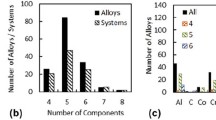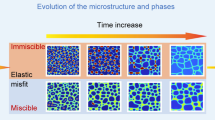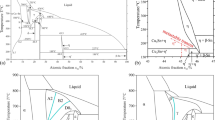Abstract
In this report, a combination of the diffusion multiple technique and the recently developed pragmatic numerical inverse method was employed for a high-throughput determination of interdiffusivity matrices in Co-Cr-FeMn-Ni high-entropy alloys (HEAs). Firstly, one face-centered cubic (fcc) quinary Co-Cr-Fe-Mn-Ni diffusion multiple at 1373 K was carefully prepared by means of the hot-pressing technique. Based on the composition profiles measured by the field emission electron probe micro analysis (FE-EPMA), the composition-dependent interdiffusivity matrices in quinary Co-Cr-Fe-Mn-Ni system at 1373 K were then efficiently determined using the pragmatic numerical inverse method. The determined interdiffusivities show good agreement with the limited results available in the literature. Moreover, the further comparison with the interdiffusivities in the lower-order systems indicates the sluggish diffusion effect in Co-Cr-Fe-Mn-Ni HEAs, which is however not observed in tracer diffusivities. In order for the convenience in further analysis, a generalized transformation relation among interdiffusivities with different dependent components in multicomponent systems was finally derived.




Similar content being viewed by others
References
M.C. Gao, B. Zhang, S.M. Guo, J.W. Qiao, and J.A. Hawk, High-Entropy Alloys in Hexagonal Close-Packed Structure, Metall. Mater. Trans. A, 2016, 47, p 3322-3332
J. Morral, Skepticism, Science and High Entropy Alloys, J. Phase Equilib. Diff., 2015, 36, p 305
D.B. Miraclea and O.N. Senkov, A Critical Review of High Entropy Alloys and Related Concepts, Acta Mater., 2017, 122, p 448-511
K.Y. Tsai, M.H. Tsai, and J.W. Yeh, Sluggish Diffusion in Co-Cr-Fe-Mn-Ni High-entropy Alloys, Acta Mater., 2013, 61, p 4887-4897
F. Zhang and U. Kattner, CALPHAD and the High Entropy Alloy, J. Phase Equilib. Diff., 2015, 36, p 1-2
B. Schuh, F. Mendez-Martin, B. Völker, E.P. George, H. Clemens, R. Pippan, and A. Hohenwarter, Mechanical Properties, Microstructure and Thermal Stability of a Nanocrystalline CoCrFeMnNi High-Entropy Alloy After Severe Plastic Deformation, Acta Mater., 2015, 96, p 258-268
A. Chyrkin, A. Epishin, R. Pillai, T. Link, G. Noize, and W.J. Quadakkers, Modeling Interdiffusion Processes in CMSX-10/Ni Diffusion Couple, J. Phase Equilib. Diff., 2016, 37, p 201-211
F. Faupel, W. Frank, M.-P. Macht, H. Mehrer, V. Naundorf, K. Rätzke, H.R. Schober, S.K. Sharma, and H. Teichler, Diffusion in Metallic Glasses and Supercooled Melts, Rev. Mod. Phys., 2003, 75, p 237-280
R.F. Sekerka, G.B. McFadden, and W.J. Boettinger, Analytical Derivation of the Sauer-Freise Flux Equation for Multicomponent Multiphase Diffusion Couples with Variable Partial Molar Volumes, J. Phase Equilib. Diffus., 2016, 37, p 640-650
W. Chen, L. Zhang, Y. Du, C. Tang, and B. Huang, A Pragmatic Method to Determine the Composition-Dependent Interdiffusivities in Ternary Systems by Using a Single Diffusion Couple, Scripta Mater., 2014, 90–91, p 53-56
W. Chen, J. Zhong, and L. Zhang, An Augmented Numerical Inverse Method for Determining the Composition-Dependent Interdiffusivities in Alloy Systems by Using a Single Diffusion Couple, MRS Comm., 2016, 6, p 295-300
H. Xu, W. Chen, L. Zhang, Y. Du, and C. Tang, High-throughput Determination of the Composition-Dependent Interdiffusivities in Cu-rich Fcc Cu-Ag-Sn Alloys at 1073 K, J. Alloys Compd., 2015, 644, p 687-693
J. Chen, L. Zhang, J. Zhong, W. Chen, and Y. Du, High-throughput Measurement of the Composition-Dependent Interdiffusivity Matrices in Ni-rich Fcc Ni-Al-Ta Alloys at Elevated Temperatures, J. Alloys Compd., 2016, 688, p 320-328
S. Deng, W. Chen, J. Zhong, L. Zhang, Y. Du, and L. Chen, Diffusion Study in Bcc_A2 Fe-Mn-Si System: Experimental Measurement and CALPHAD Assessment, CALPHAD, 2017, 56, p 230-240
J.-C. Zhao, M.R. Jackson, L.A. Peluso, and L.N. Brewer, A Diffusion-Multiple Approach for Mapping Phase Diagrams, Hardness, and Elastic Modulus, JOM, 2002, 54, p 42-45
J.-C. Zhao, X. Zheng, and D.G. Cahill, High-Throughput Diffusion Multiples, Mater. Today, 2005, 8, p 28-37
J.-C. Zhao, Reliability of the Diffusion-Multiple Approach for Phase Diagram Mapping, J. Mater. Sci., 2004, 39, p 3913-3925
J.-C. Zhao, Combinatorial Approaches as Effective Tools in the Study of Phase Diagrams and Composition-Structure-Property Relationships, Prog. Mater Sci., 2006, 51, p 557-631
K. Kulkarni and G.P.S. Chauhan, Investigations of Quaternary Interdiffusion in a Constituent System of High Entropy Alloys, AIP Adv., 2015, 5, p 097162
Y.W. Cui, M. Jiang, I. Ohnuma, K. Oikawa, R. Kainuma, and K. Ishida, Computational Study of Atomic Mobility in Co-Fe-Ni Ternary Fcc Alloys, J. Phase Equilib. Diffus., 2008, 29, p 312-321
M. Vaidya, S. Trubel, B.S. Murty, G. Wilde, and S.V. Divinski, Ni Tracer Diffusion in CoCrFeNi and CoCrFeMnNi High Entropy Alloys, J. Alloys Compd., 2016, 688, p 994-1001
B. Million, J. Růžičková, J. Velíšek, and J. Vřešťál, Diffusion Processes in the Fe-Ni System, Mater. Sci. Eng., 1981, 50, p 43-52
S.J. Rothman, L.J. Nowicki, and G.E. Murch, Self-Diffusion in Austenitic Fe-Cr-Ni Alloys, J. Phys. F: Met. Phys., 1980, 10, p 383-398
B. Million and J. Kučera, Concentration Dependence of Nickel Diffusion in Nickel-Cobalt Alloys, Czech. J. Phys. B, 1971, 21, p 161-171
J.R. Manning, Diffusion and the Kirkendall Shift in Binary Alloys, Acta Metall., 1967, 15, p 817-826
W. Chen, L. Zhang, Y. Du, and B. Huang, Viscosity and Diffusivity in Melts: From Unary to Multicomponent Systems, Philos. Mag., 2014, 94, p 1552-1577
W. Zhang, Y. Du, W. Chen, Y. Peng, P. Zhou, S. Wang, G. Wen, and W. Xie, CSUDDCC1—A Diffusion Database for Multicomponent Cemented Carbides, Int. J. Refract. Met. Hard Mater., 2014, 43, p 164-180
F. Sauer and V.Z. Freise, Diffusion in Binären Gemischen mit Volumenänderung, Z. Elektrochem., 1962, 66, p 353-362
A. Ben Abdellah, J.G. Gasser, K. Bouziane, B. Grosdidier, and M. Busaidi, Experimental Procedure to Determine the Interdiffusion Coefficient of Miscibility Gap Liquid Alloys: Case of GaPb System, Phys. Rev. B, 2007, 76, p 174203
J. Lechelle, S. Noyau, L. Aufore, A. Arredondo and E. Audubert, Volume Interdiffusion Coefficient and Uncertainty Assessment for Polycrystalline Materials. Diffusion-fundamentals.org, 2012, 17, p 1–39.
N.G. Jones, R. Izzo, P.M. Mignanelli, K.A. Christofidou, and H.J. Stone, Phase Evolution in an Al0.5CrFeCoNiCu High Entropy Alloy, Intermetallics, 2016, 71, p 43-50
Acknowledgments
The financial support from the National Natural Science Foundation of China (Grant No. 51474239), the National Key Research and Development Program of China (Grant No. 2016YFB0301101) and the Hunan Provincial Natural Science Foundation for Youth of China (Grant No. 2015JJ3146) is acknowledged. Weimin Chen acknowledges the financial support from Guangdong Provincial Natural Science Foundation for Doctoral Research Project, the Innovation Foundation of Jinan University (Grant No. 21617340) and the Scientific Research Funds for the Talents of Jinan University, Guangzhou, China. Lijun Zhang acknowledges the project supported by State Key Laboratory of Powder Metallurgy Foundation, Central South University, Changsha, China.
Author information
Authors and Affiliations
Corresponding author
Electronic supplementary material
Below is the link to the electronic supplementary material.
Appendix
Appendix
In an N-component system, the interdiffusion flux of a component i under constant molar volume can be expressed by Fick’s first law,
Then, one can obtain
In fact, Eq 9-11 are presented when the component N is treated as the dependent component. If the component N − 1 is selected as the dependent component, one can have
Considered the relation (\(\frac{{\partial c_{N} }}{\partial x} = - \sum\limits_{j = 1}^{N - 1} {(\frac{{\partial c_{j} }}{\partial x})}\)), Eq 12 and 13 can be revised as,
A direct comparison between Eq A6 with Eq A4 leads to,
By substituting Eq 14 into Eq 15, one can obtain
A direct comparison between Eq 17 with Eq 11 leads to,
According to the above mathematical derivations, a generalized transformation relation in an N-component system is achieved.
Rights and permissions
About this article
Cite this article
Chen, W., Zhang, L. High-Throughput Determination of Interdiffusion Coefficients for Co-Cr-Fe-Mn-Ni High-Entropy Alloys. J. Phase Equilib. Diffus. 38, 457–465 (2017). https://doi.org/10.1007/s11669-017-0569-0
Received:
Revised:
Published:
Issue Date:
DOI: https://doi.org/10.1007/s11669-017-0569-0




